Integration of Well Logging and Seismic Data for the Prognosis of Reservoir Properties of Carbonates
Abstract
1. Introduction
Geological Settings
2. Methods
- -
- Classification analyses of interparameters on cross-plots based on well data (determining petroelastic facies/lithofacies and characterizing other parameters relevant to specific objectives, e.g., identifying zones with enhanced reservoir properties).
- -
- Integration of the obtained results with seismic data (seismic inversion).
- -
- Based on the above, subsequent parametric modeling along with conventional geostatistical data analysis.
- Lithological/Lithofacial Analyses—According to the proposed methodology, the foundation for the spatial characterization of the reservoir lies in defining lithological/lithofacial classes with diversified ranges of both elastic and petrophysical parameter values. This is the most crucial step, as its outcome determines the results of subsequent stages of reservoir characterization.
- Characterization of Well Data—Within the identified lithological/lithofacial classes from the earlier stage, an analysis of the parametric variability in significant parameters (acoustic impedance AI, compressional wave velocity and shear wave velocity ratio VpVs, porosity PHI, Young modulus YM, Poisson ratio PR, and Stoneley wave velocity Vstoneley) is conducted. Their ranges of values are determined and applied in the geostatistical modeling stage. In the case of carbonate reservoirs, it is crucial to characterize the occurrence of intervals susceptible to mechanical damage (potential occurrence of fractures).
- Determination of Fluid Saturation Classes and Zones with Enhanced Reservoir Properties—Cross-plot analyses characterize the variability in fluid saturation in well log profiles. They identify classes of hydrocarbon saturation and determine intervals with the highest potential for fracture occurrence. The results from this stage will ultimately support the spatial identification of key areas.
- 4.
- Seismic Inversion—The procedure of inverting three fundamental parameters: AI, Vp, and VpVs are undertaken. The results of this stage are constituted by secondary data aiding in determining trends in the distribution of interdependent well data parameters. Examining the relationship between seismic volume amplitudes and averaged compressional wave velocities in well profiles at vertical grid resolution revealed a correlation value of 0.3, which was insufficient to justify direct utilization of the amplitude volume as a controlling parameter for the spatial distribution of Vp and other parameters with similarly low correlation levels. Consequently, a seismic inversion procedure was conducted. Subsequently, a simultaneous inversion of several parameters (PHI, RHOB, Vp, Vs, AI, Vp/Vs, Young’s modulus, Poisson’s ratio, and Stoneley wave velocities) was performed, basing the inversion on well logs; structural surfaces (top and base of Main Dolomite); and seismic data (amplitude volume)—guiding the spatial distribution of inversion parameters.
- 5.
- Lithological/Lithofacial Modeling—The outcomes of the initial analyses in well profiles undergo spatial distribution using geostatistical tools and the results of seismic inversion. Individual subsequent analyses are conducted within the scope of the occurrence of distinct lithologies/lithofacies.
- 6.
- Parametric Modeling (AI, VpVs, PHI, YM, PR, and VStoneley)—Spatial parametric modeling is independently performed within each defined class based on the interpretations of well geophysical curves and inversion results. The relationship derived from the second stage of analyses in well profiles is reproduced, and the application of geostatistical tools ensures the physical nature of the final modeling outcome.
- 7.
- Classification Model of Fluid Saturation and Zones with Enhanced Reservoir Properties—Ultimately, within the developed parametric model, a qualitative model of fluid saturation is reconstructed, reflecting the classification results of this parameter in well profiles. Sequentially, a spatial distribution of zones indicating potentially increased occurrence of fractures is similarly reproduced.
3. Results and Discussion
3.1. Analyses in Well Log Profiles
- (1)
- Microfacies analysis
- (2)
- Characterization of Well Data
- (3)
- Determining classes of fluid saturation within the reservoir and intervals exhibiting enhanced reservoir properties
3.2. The Application of Well Analysis Results in Spatially Characterizing the Area
- (4)
- Seismic inversion
- (5)
- Parametrical modeling
- (6)
- The classification model of fluid saturation
4. Discussion
4.1. Identification of Zones with the Highest Hydrocarbon Accumulation Potential
4.2. Identification of Intervals Susceptible to Mechanical Damage
Author Contributions
Funding
Data Availability Statement
Acknowledgments
Conflicts of Interest
References
- Dernaika, M.R.; Sinclair, G.G. Resolving the Link between Porosity and Permeability in Carbonate Pore Systems. In Proceedings of the International Symposium of the Society of Core Analysts, Vienna, Austria, 7 August–1 September 2017. Paper SCA2017-77. [Google Scholar]
- Stadtműller, M.; Jarzyna, J.A. Estimation of Petrophysical Parameters of Carbonates Based on Well Logs and Laboratory Measurements, a Review. Energies 2023, 16, 4215. [Google Scholar] [CrossRef]
- Dasgupta, T.; Mukherjee, S. Sediment Compaction and Applications in Petroleum Geoscience, Advances in Oil and Gas Exploration & Production; Springer Nature AG: Cham, Switzerland, 2020. [Google Scholar] [CrossRef]
- Ranjith, P.G.; Viete, D.R. Applicability of the ‘cubic law’ for non-Darcian fracture flow. J. Pet. Sci. Eng. 2011, 78, 321–327. [Google Scholar] [CrossRef]
- Radwan, A.E.; Trippetta, F.; Kassem, A.A.; Kania, M. Multi-Scale Characterization of an Unconventional Tight Carbonate 367 Reservoir: Insights from the October Oil Field, Gulf of Suez Rift Basin, Egypt. J. Pet. Sci. Eng. 2021, 368, 107968. [Google Scholar] [CrossRef]
- Rashid, F.; Hussein, D.; Lawrence, J.A.; Khanaqa, P. Characterization and Impact on Reservoir Quality of Fractures in 370 the Cretaceous Qamchuqa Formation, Zagros Folded Belt. Mar. Pet. Geol. 2020, 113, 104117. [Google Scholar] [CrossRef]
- Shehata, A.A.; Kassem, A.A.; Brooks, H.L.; Zuchuat, V.; Radwan, A.E. Facies Analysis and Sequence-Stratigraphic Con-372 trol on Reservoir Architecture: Example from Mixed Carbonate/Siliciclastic Sediments of the Raha Formation, Gulf of Suez, 373 Egypt. Mar. Pet. Geol. 2021, 131, 105160. [Google Scholar] [CrossRef]
- Ødegaard, E.; Avseth, P. Interpretation of Elastic Inversion Results Using Rock Physics Templates. In Proceedings of the 65th EAGE Conference & Exhibition, Stavanger, Norway, 2–5 June 2003. [Google Scholar] [CrossRef]
- Dvorkin, J.; Nur, A. Elasticity of High-Porosity Sandstones: Theory for Two North Sea Data Sets. Geophysics 1996, 61, 1363–1370. [Google Scholar] [CrossRef]
- Hilman, J.; Winardhi, I.S. Rock Physics Template Application on Carbonate Reservoir. IOP Conf. Ser. Earth Environ. Sci. 2019, 318, 012006. [Google Scholar] [CrossRef]
- Jaworowski, K.; Mikolajewski, Z. Oil- and Gas-Bearing Sediments of the Main Dolomite (Ca2) in the Miedzychód 342 Region: A Depositional Model and the Problem of the Boundary between the Second and Third Depositional Sequences in the 343 Polish Zechstein Basin. Prz. Geol. 2007, 55, 1017–1024. [Google Scholar]
- Mikołajewski, Z.; Wróbel, M. Petrography and Diagenesis of the Cretaceous Main Dolomite (Ca2) in the Lubiatów Oil 354 Field Area (Western Poland). Prz. Geol. 2005, 53, 335–336. [Google Scholar]
- Mikołajewski, Z.; Słowakiewicz, M. Microfacies and diagenesis of the Main Dolomite (Ca2) strata in the Międzychód 356 barrier area (Grotów Peninsula, Western Poland). Biul. Państw. Inst. Geol. 2008, 429, 191–198. [Google Scholar]
- Matyasik, I.; Leśniak, G.; Such, P.; Mikołajewski, Z. Mixed wetted carbonate reservoir: Origins of mixed wettability and 352 affecting reservoir properties. Ann. Soc. Geol. Pol. 2010, 80, 115–122. [Google Scholar]
- Kotarba, M.; Wagner, R. Generation potential of the Zechstein Main Dolomite (Ca2) carbonates in the Gorzów Wielko-348 polski-Midzychód-Lubiatów area: Geological and geochemical approach to microbial-algal source rock. Prz. Geol. 2007, 55, 1025–1036. [Google Scholar]
- Pikulski, L. Analiza paleogeograficzna utworów dolomitu głównego (Ca2) w rejonie Lubiatów-Międzychód-Grotów w 365 aspekcie poszukiwania złóż. Nafta-Gaz 2004, 60, 397–405. [Google Scholar]
- Skupio, R.; Kubik, B.; Drabik, K.; Przelaskowska, A. Kompleksowa interpretacja profilu otworu obejmującego skały 375 anhydrytowe, węglanowe i mułowcowe wykonana na podstawie badań rdzeni wiertniczych z zastosowaniem metod 376 nieniszczących. Nafta-Gaz 2022, 78, 641–653. [Google Scholar] [CrossRef]
- Urbaniec, A.; Drabik, K.; Dohnalik, M.; Zagórska, U.; Kowalska, S. Możliwości Rozpoznania Wybranych Cech Skał 387 Węglanowych na Podstawie Obrazu Tomografii Komputerowej (CT) Oraz Skanera Mikroopornościowego (XRMI); The Oil and Gas Institute-National Research Institute: Kraków, Poland, 2019. [Google Scholar] [CrossRef]
- Stadtműller, M.; Krakowska-Madejska, P.I.; Leśniak, G.; Jarzyna, J.A. Characterization of the Carbonate Formation Fracture System Based on Well Logging Data and Results of Laboratory Measurements. Energies 2021, 14, 6034. [Google Scholar] [CrossRef]
- Kaczmarczyk-Kuszpit, W.; Brodzicki, A. The use of artificial neural network techniques to predict selected parameters 345 as a supplement to the input data set in the construction of 3D parametric models. Nafta-Gaz 2021, 77, 429–445. [Google Scholar] [CrossRef]
- Niepsuj, M.; Krakowska-Madejska, P. Analysis and modeling of petrophysical parameters of the Main Dolomite for-358 mation on the basis of well logging and seismic data. Geol. Geophys. Environ. 2012, 38, 317. [Google Scholar] [CrossRef][Green Version]
- Papiernik, B.; Machowski, G.; Słupczynski, K.; Semyrka, R. Geological model of the Lubiatów-Międzychód-Grotów 363 (LMG) oil-gas accumulation area. Geologia 2009, 35, 175–182. [Google Scholar]
- Smalera, N. Attribute analysis as a tool for determining the areas of the late diagenetic Main Dolomite deposits and 378 assessing the stability of the seismic signal parameters. Geol. Geophys. Environ. 2022, 48, 111–132. [Google Scholar] [CrossRef]
- Solarski, T. Porównanie porowatości utworów dolomitu głównego wyznaczonych przy pomocy różnych metod inwersji 381 sejsmicznej. In Prace Instytutu Nafty i Gazu nr 170; Instytut Nafty i Gazu-Państwowy Instytut Badawczy: Kraków, Poland, 2010; pp. 503–507. [Google Scholar]
- Topór, T.; Sowiżdżał, K. An advanced ensemble modeling approach for predicting carbonate reservoir porosity from 385 seismic attributes. Geol. Geophys. Environ. 2023, 49, 245–260. [Google Scholar] [CrossRef]
- Wawrzyniak-Guz, K. Rock physics modelling for determination of effective elastic properties of the lower Paleozoic shale formation, North Poland. Acta Geophys. 2019, 67, 1967–1989. [Google Scholar] [CrossRef]
- Avseth, P.; Jørstad, A.; van Wijngaarden, A.J.; Mavko, G. Rock physics estimation of cement volume, sorting, and net-to-gross in North Sea sandstones. Lead. Edge 2009, 28, 98–108. [Google Scholar] [CrossRef]
- Azevedo, L.; Grana, D.; Amaro, C. Geostatistical rock physics AVA inversion. Geophys. J. Int. 2019, 216, 1728–1739. [Google Scholar] [CrossRef]
- Durrani, M.Z.A.; Talib, M.; Sarosh, B. Rock physics-driven quantitative seismic reservoir characterization of a tight gas reservoir: A case study from the Lower Indus Basin in Pakistan. First Break 2020, 38, 43–53. [Google Scholar] [CrossRef]
- Roncarolo, F.; Grana, D. Improved Reservoir Characterization Integrating Seismic Inversion, Rock Physics Model, and Petroelastic Log Facies Classification: A Real Case Application. In Proceedings of the SPE Annual Technical Conference and Exhibition, Florence, Italy, 20–22 September 2010. [Google Scholar] [CrossRef]
- Sowiżdżał, K. Geological 3D modeling of hydrocarbon reservoirs—Methodological aspects and case studies. In Prace 383 Naukowe Instytutu Nafty i Gazu No. 192; Instytut Nafty i Gazu-Państwowy Instytut Badawczy: Kraków, Poland, 2013; pp. 1–217. [Google Scholar]
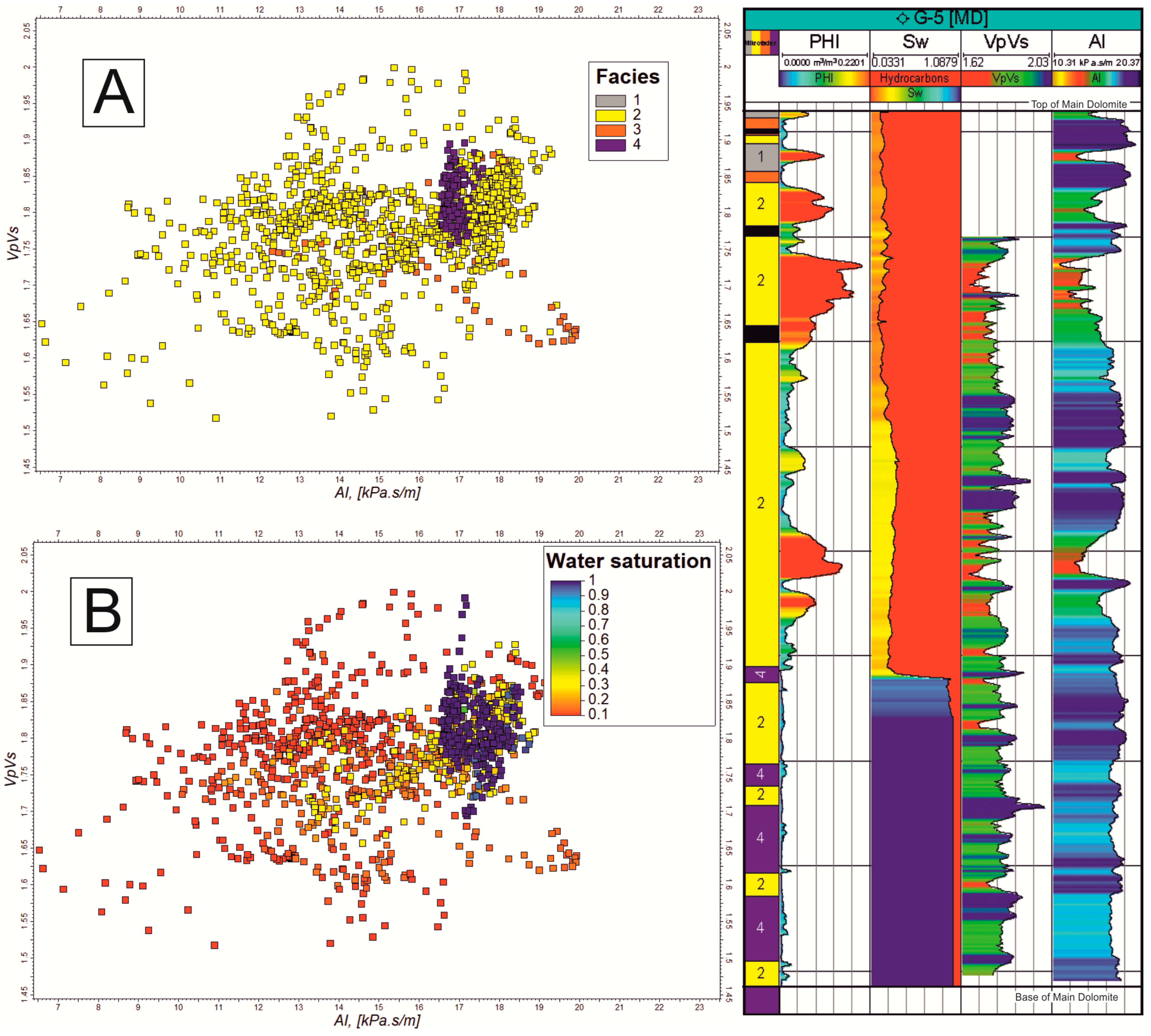
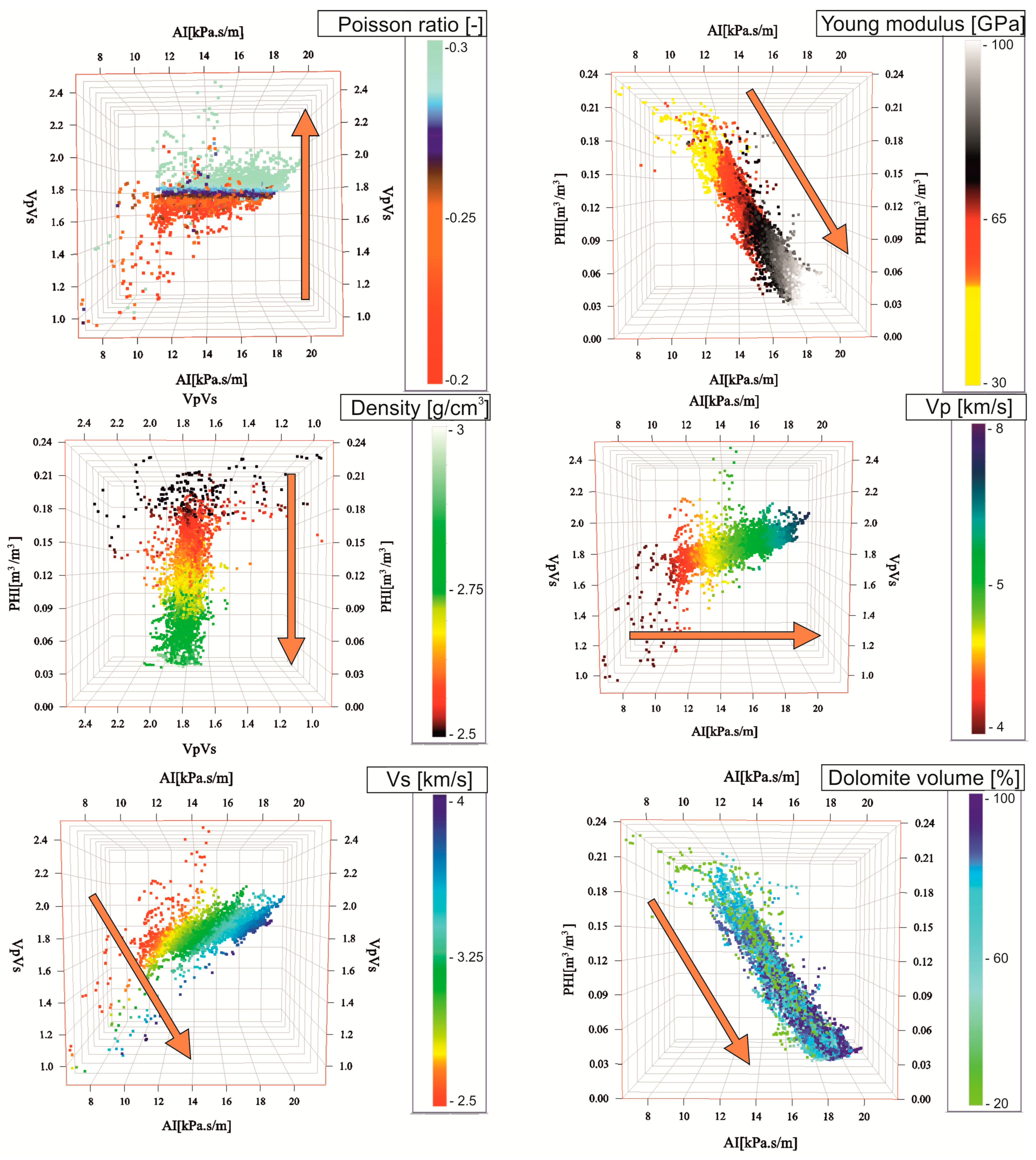
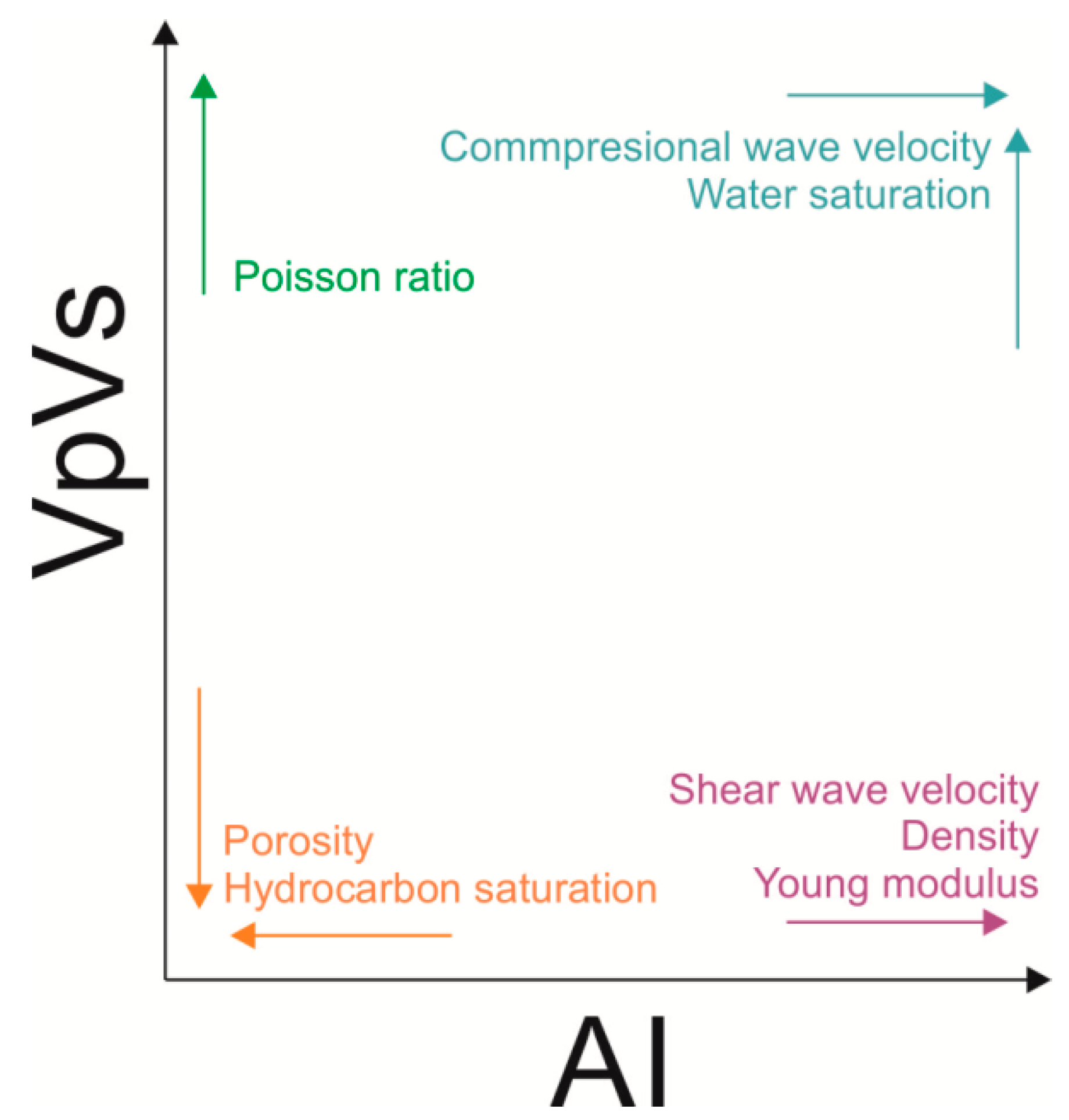
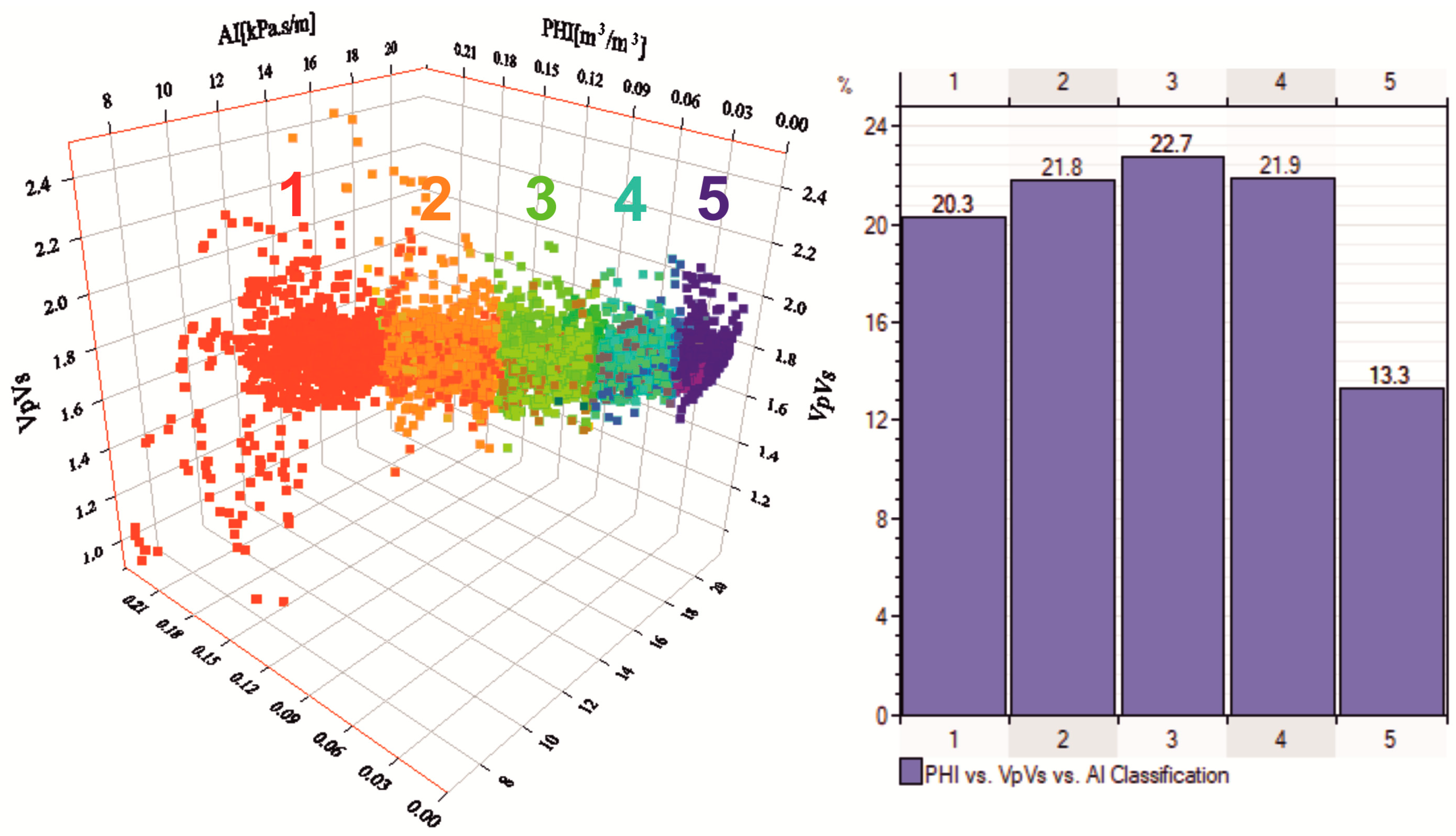
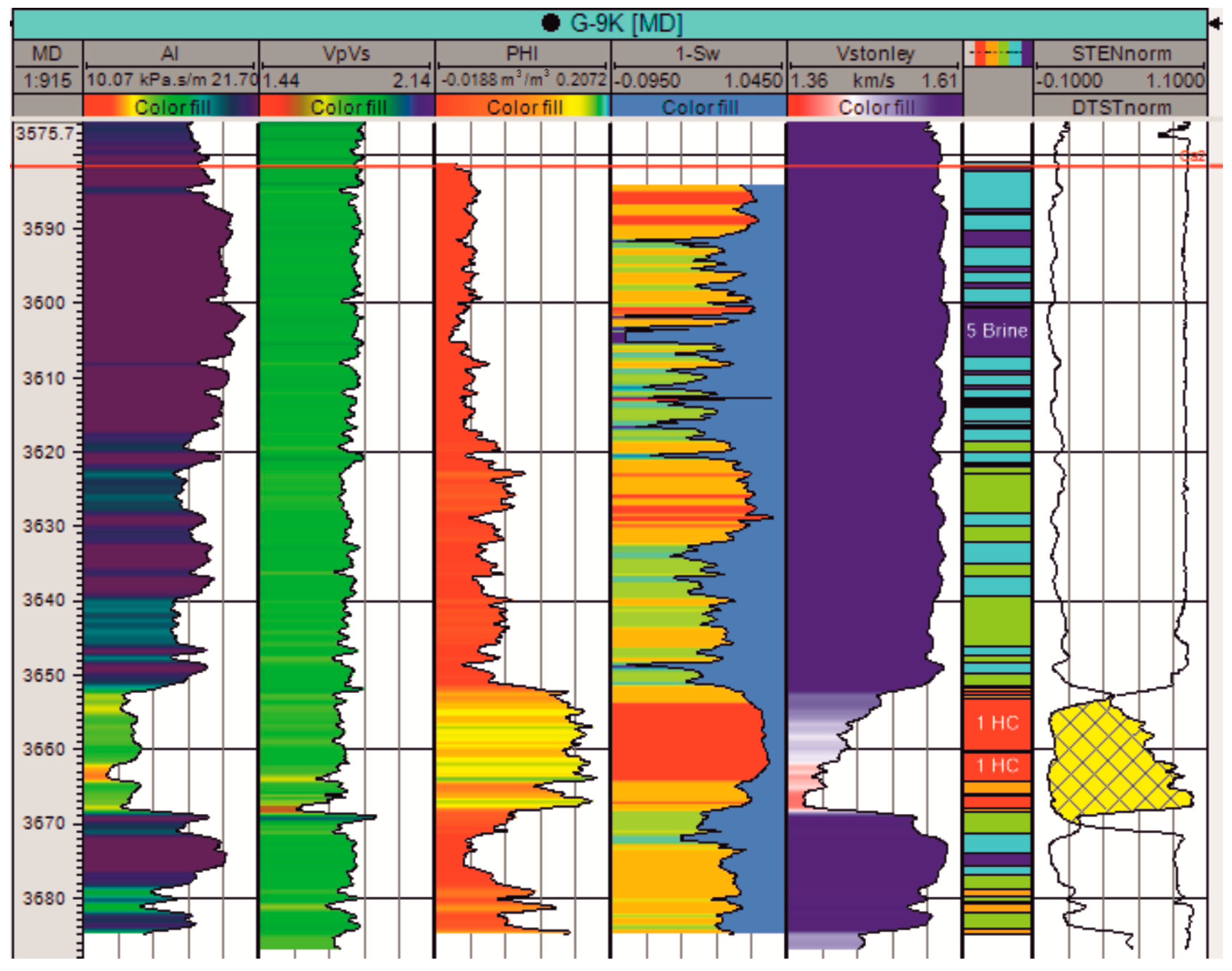
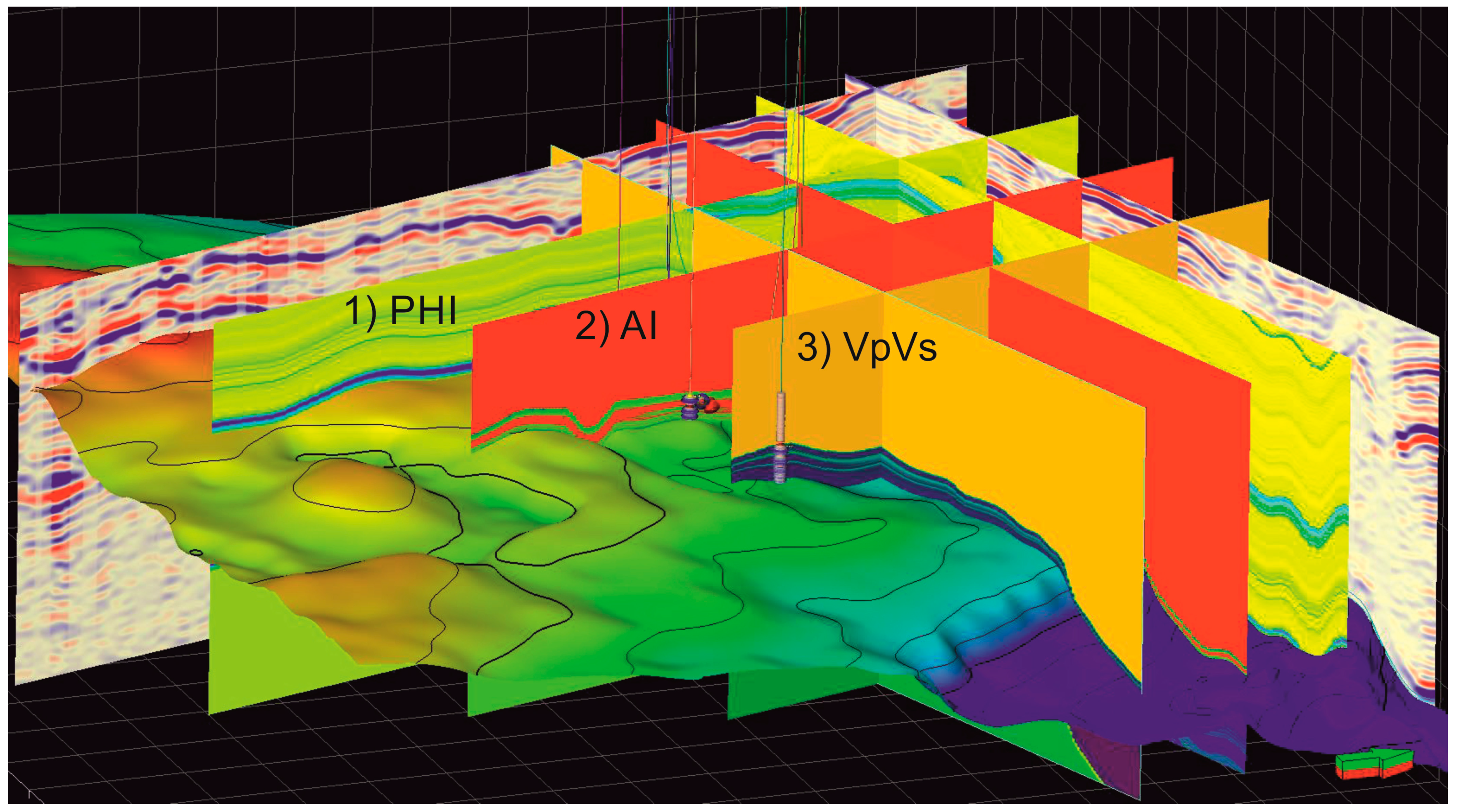
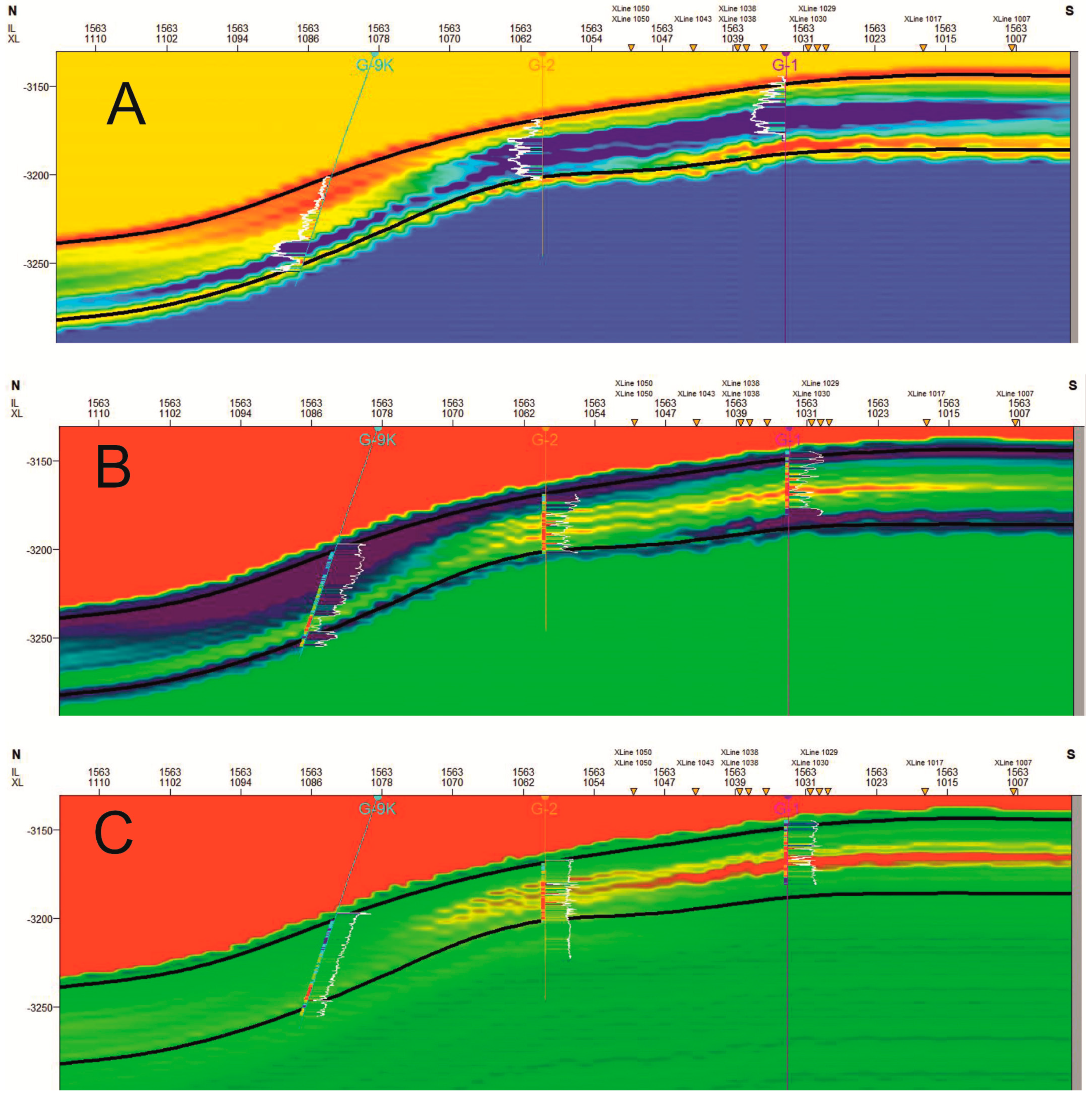
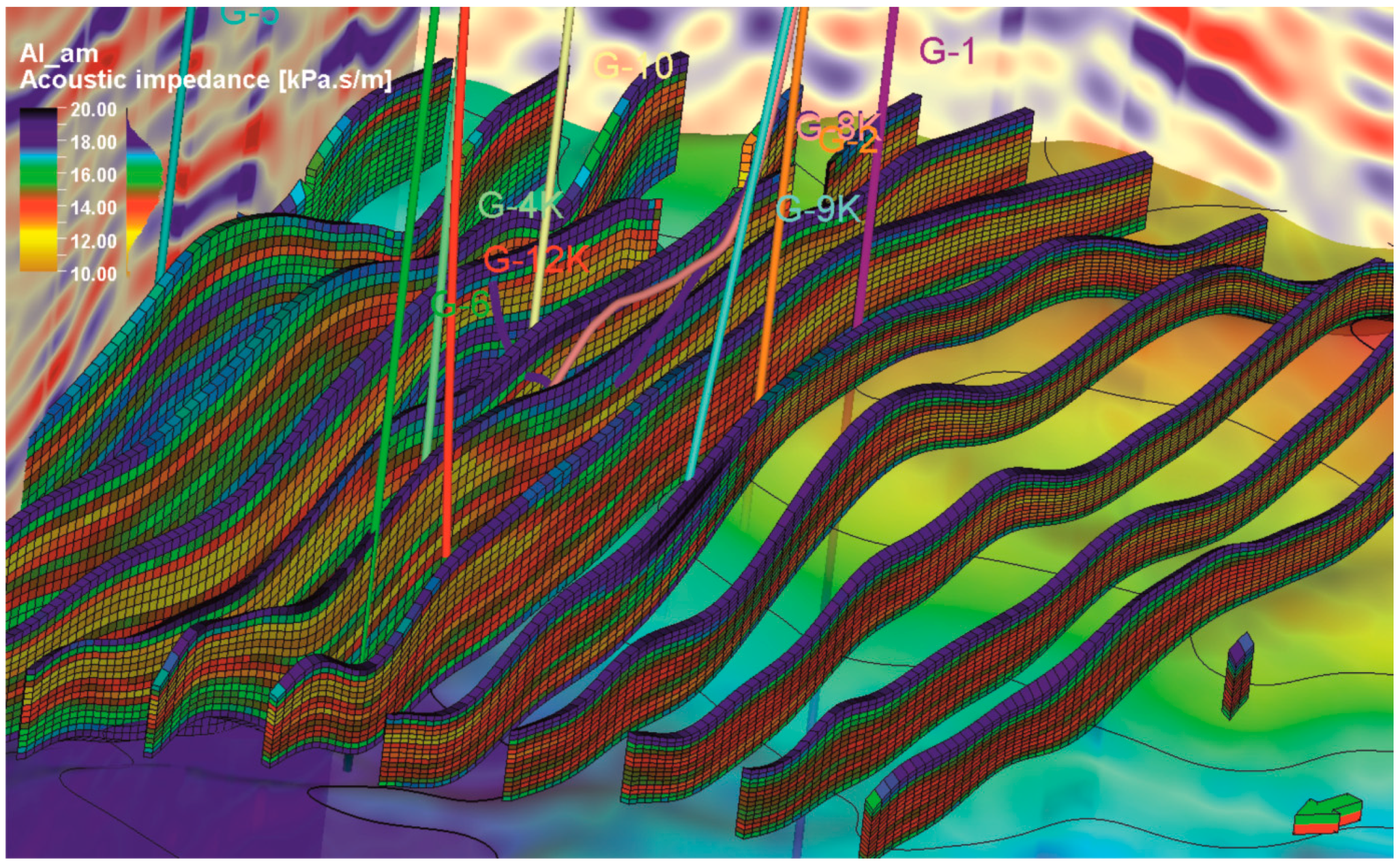

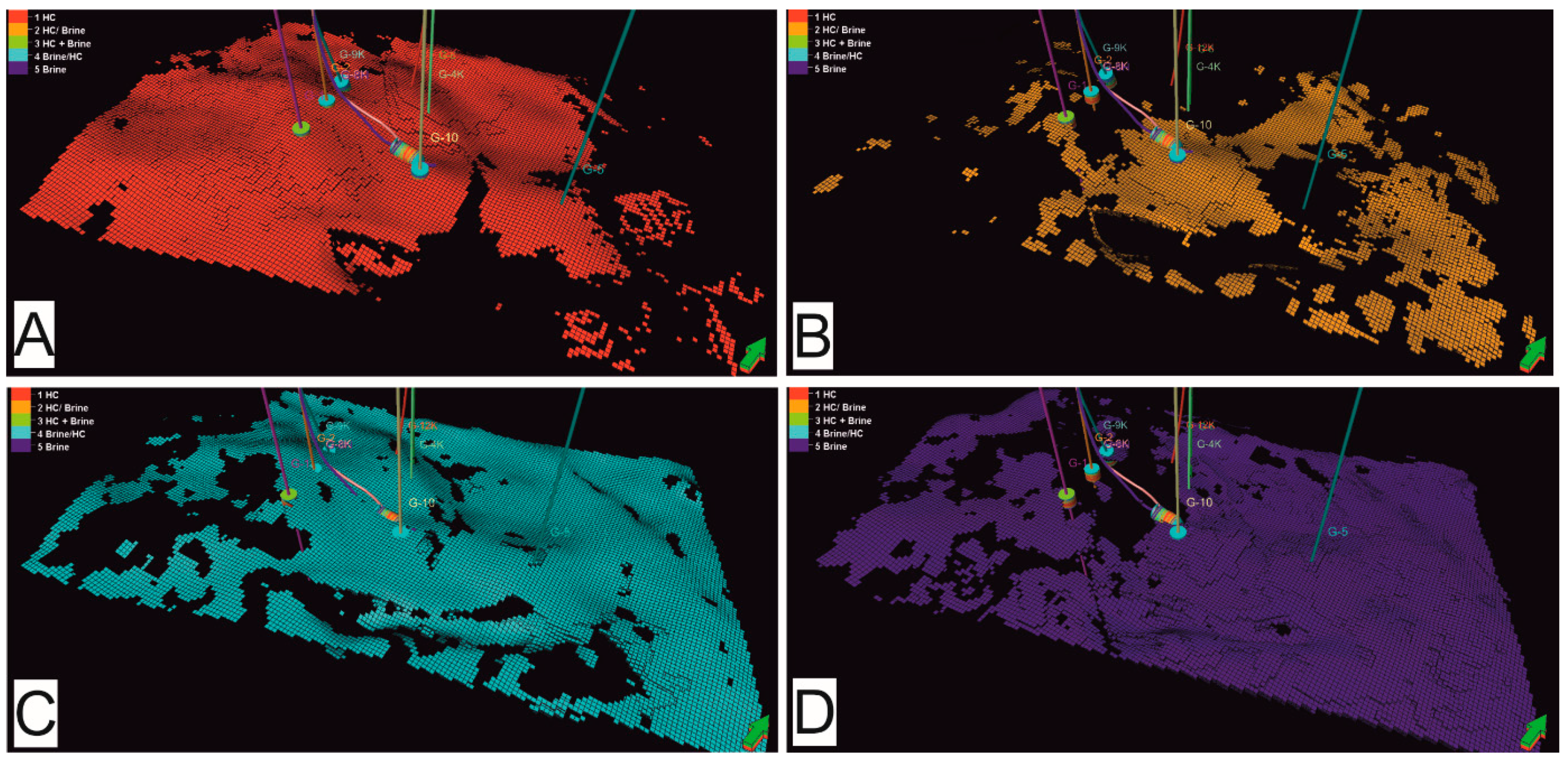

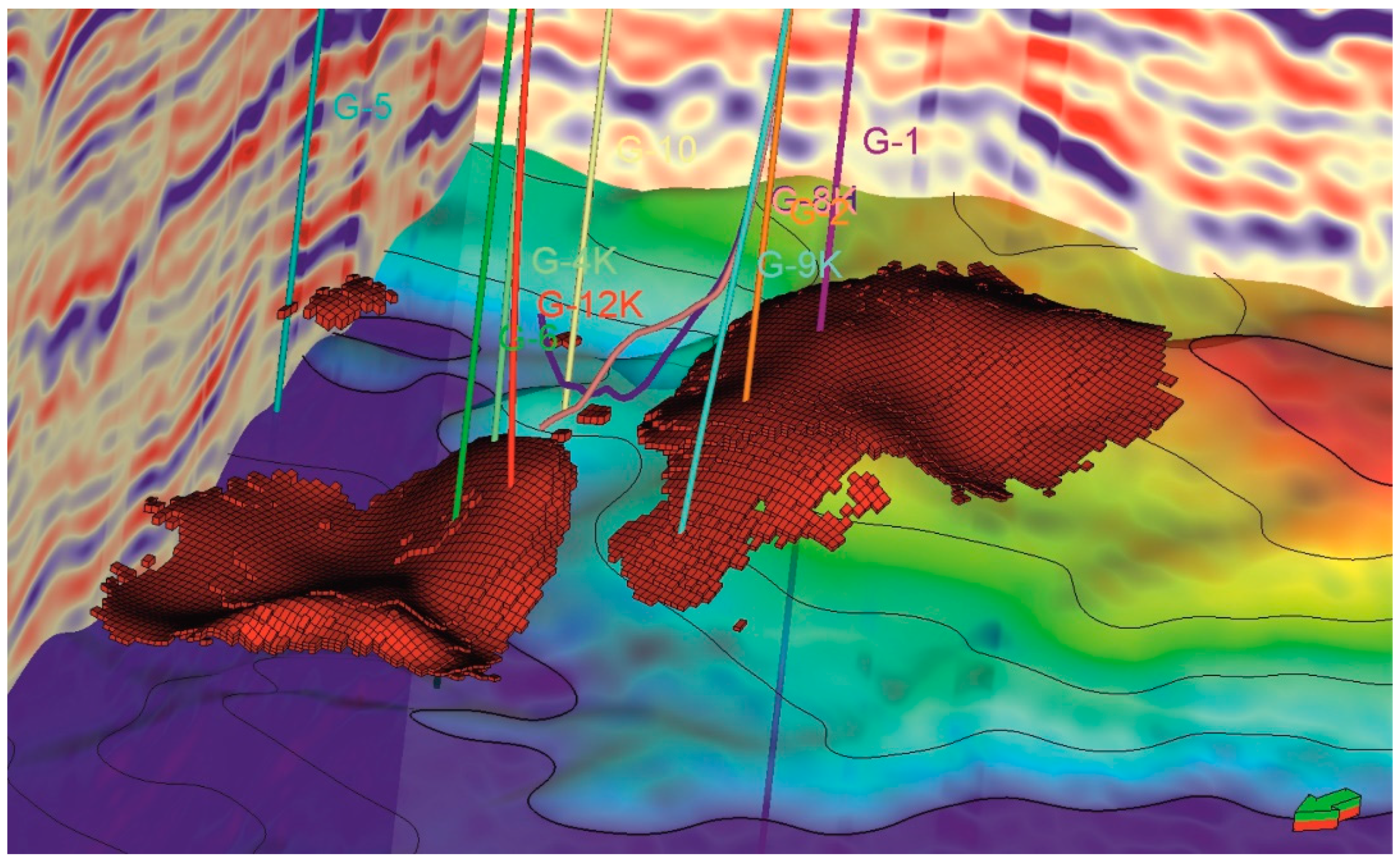
Disclaimer/Publisher’s Note: The statements, opinions and data contained in all publications are solely those of the individual author(s) and contributor(s) and not of MDPI and/or the editor(s). MDPI and/or the editor(s) disclaim responsibility for any injury to people or property resulting from any ideas, methods, instructions or products referred to in the content. |
© 2024 by the authors. Licensee MDPI, Basel, Switzerland. This article is an open access article distributed under the terms and conditions of the Creative Commons Attribution (CC BY) license (https://creativecommons.org/licenses/by/4.0/).
Share and Cite
Kaczmarczyk-Kuszpit, W.; Sowiżdżał, K. Integration of Well Logging and Seismic Data for the Prognosis of Reservoir Properties of Carbonates. Energies 2024, 17, 355. https://doi.org/10.3390/en17020355
Kaczmarczyk-Kuszpit W, Sowiżdżał K. Integration of Well Logging and Seismic Data for the Prognosis of Reservoir Properties of Carbonates. Energies. 2024; 17(2):355. https://doi.org/10.3390/en17020355
Chicago/Turabian StyleKaczmarczyk-Kuszpit, Weronika, and Krzysztof Sowiżdżał. 2024. "Integration of Well Logging and Seismic Data for the Prognosis of Reservoir Properties of Carbonates" Energies 17, no. 2: 355. https://doi.org/10.3390/en17020355
APA StyleKaczmarczyk-Kuszpit, W., & Sowiżdżał, K. (2024). Integration of Well Logging and Seismic Data for the Prognosis of Reservoir Properties of Carbonates. Energies, 17(2), 355. https://doi.org/10.3390/en17020355






